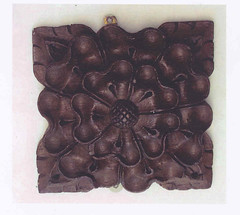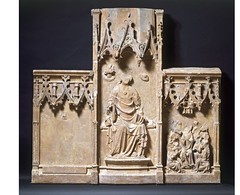By Stuart Frost
I spent a rather pleasant weekend in Blackawton a little while ago. Blackawton is a small village in Devon, not far from Totnes. I was there helping a friend set up a stall in the village hall. They were hoping to capitalise on the audience attracted to Blackawton to participate in the annual worm charming festival. Competitors are allocated a small area of ground and the team which charms the most worms to the surface in a fixed period of time wins.
After the excitement was over, and the winning team had charmed nine worms out from the earth, I wandered off to explore. At the centre of the village I found the Parish Church of St Michael. Spending so much time in London I forget how richly endowed the English landscape is with ancient churches of different sizes, many of which are treasure houses of medieval (and later) history, art and architecture.
The Church of St Michael is impressive in scale and sits above the level of the road by a good ten feet or so on an island of earth which is surrounded and contained by a dry-stone wall. The Church has an impressive grey tower (containing seven bells) and a large nave with two aisles. Inside the nave I discovered a Norman font, lead-lined, carved out of a single massive block of stone. More remarkably separating the larger nave from the smaller chancel were substantial sections of a wonderful wooden choirscreen with a Gothic perpendicular fan vault. A closer inspection revealed that the screen was decorated with the initials of Henry VIII and Katherine of Aragon. It is rare to find painted choir-screens still in-situ as most were removed and destroyed as a consequence of the Reformation in the sixteenth-century.
Looking at the scale of the church I wondered how the size of the congregation who sat in the nave when it was first built would compare with the current congregation today. I read a report recently which indicated that England is one of the fastest secularising societies in Europe. This inevitably raises thoughts about the future of England’s rural parish churches. What will the size of the congregation of the average village church be in twenty years time, and will local communities across the country be able to maintain all of these churches and their furnishings effectively for future generations? Churches receive very little financial support from external sources.
The V&A’s medieval and Renaissance collections contain several important pieces that were once installed in English and Welsh churches that were at the heart of their communities from the middle ages onwards. I’ve illustrated this blog entry with a few examples. Most were removed during renovation and restoration in the nineteenth century. I’m trying to think of ways of using the web to make connections between artefacts like these and their original churches. Click on the images to find out more about each object.

One way to establish the link between artefact and original church would be to use the “geotag” feature on Flickr published photographs.
Beautiful blog!
Hi Kim,
Thanks for the comment and the tip – I’ll look into it!
Stuart